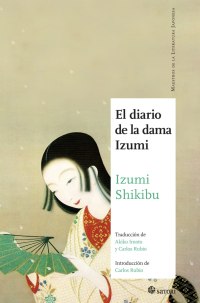
Review of the book “The Diary of Lady Izumi” by Izumi Shikibu
Would you like to read a book that transports you to 11th century Japan, to the imperial court of Kyoto, where a woman wrote her intimate and poetic diary? If the answer is yes, I recommend the book “The Diary of Lady Izumi” by Izumi Shikibu, one of the most important writers of classical Japanese literature.
Izumi Shikibu was a courtesan who lived between approximately 974 and 1034. Her diary narrates her loves and disloves, her passions and sufferings, her reflections and feelings. It is a unique testimony of the life and culture of the Heian era, one of the most refined and sophisticated in the history of Japan.
The book is composed of prose and poetry, since it was customary at that time to express oneself through verses called waka. These poems are short and delicate, capturing the essence of emotions and impressions of nature. Izumi Shikibu was a master in the art of waka, and her poems are considered gems of universal literature.
The Diary of Lady Izumi is a book that will make you feel and think, that will show you an unknown facet of the Japanese woman, that will surprise you with its modernity and beauty. It is a work that you cannot stop reading if you are interested in Japanese culture or if you simply want to enjoy a good read.
“The Diary of Lady Izumi” is an exceptional literary work written by the Japanese poet and writer Izumi Shikibu. The work is a collection of poems and diaries that recount the author’s life at the imperial court of Kyoto during the 10th century. The work is considered one of the masterpieces of Japanese literature and offers a unique vision of life in the imperial court and Japanese culture of the time.
The work focuses on the life of the author, who was one of the most prominent poets of her time and an influential figure in the imperial court. Through her diaries and poems, readers witness how Izumi Shikibu evolves and grows, facing the challenges and difficulties that life at the imperial court presents. The narrative is rich in detail and delves into the author’s motivations and thoughts, allowing readers to connect with her on a deeper level.
One of the highlights of “The Diary of Lady Izumi” is the way the author uses poetry to express her thoughts and emotions. Izumi Shikibu’s poems are a testament to her exceptional ability to create vivid, evocative images that capture the essence of life at the imperial court. The author uses a variety of poetic forms, including tanka and waka, to create a literary work that is both beautiful and moving.
Izumi Shikibu’s writing style is poetic and evocative, making reading “The Diary of Lady Izumi” an unforgettable experience. The author uses descriptive and evocative language to create a realistic and fascinating world that captivates the reader’s imagination. The work also offers a unique insight into Japanese culture of the time, including the customs and traditions of the imperial court.
In summary, “The Diary of Lady Izumi” is an exceptional work of literature that combines an immersive narrative with poetic prose and a deep knowledge of Japanese culture. This work is a must-read for those seeking to immerse themselves in a world of poetry and reflection, and will undoubtedly leave a lasting impression on all who read it.
Source: https://algunoslibrosbuenos.com/el-diario-de-la-dama-izumi


